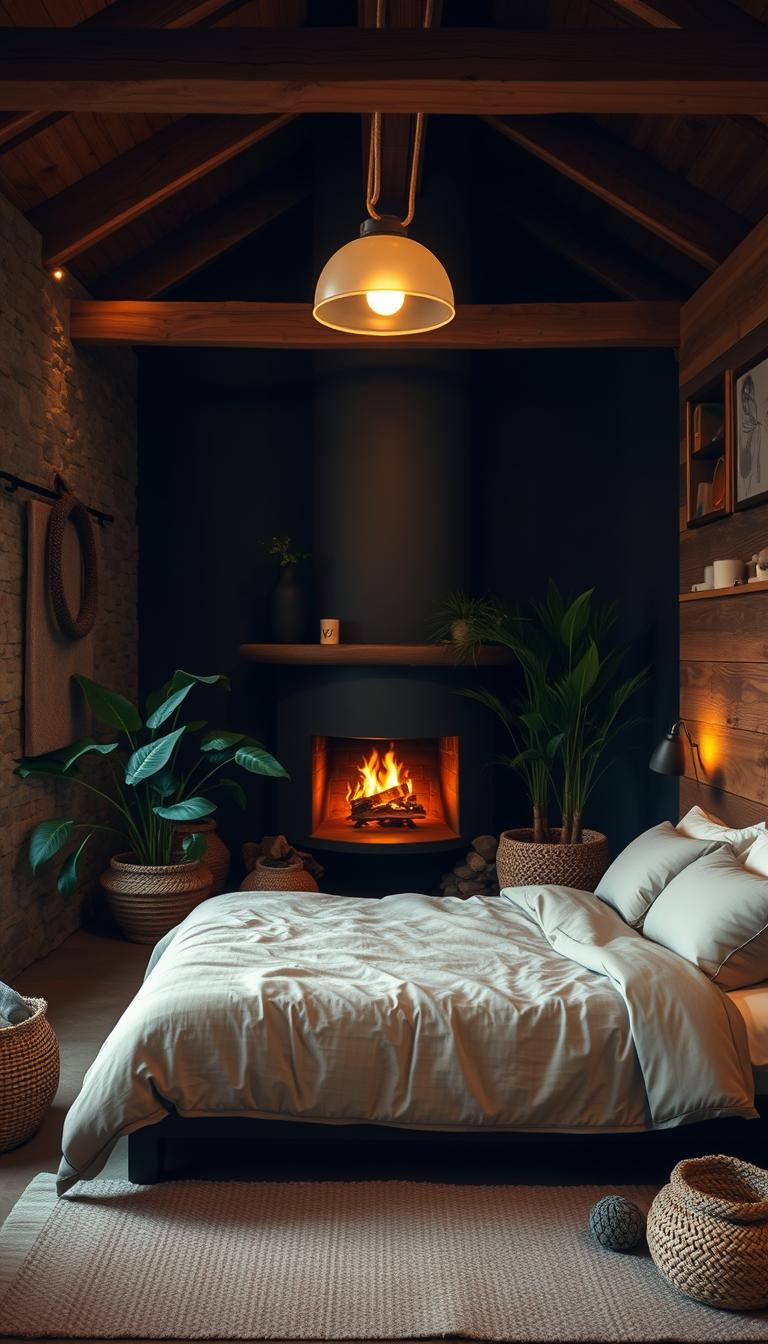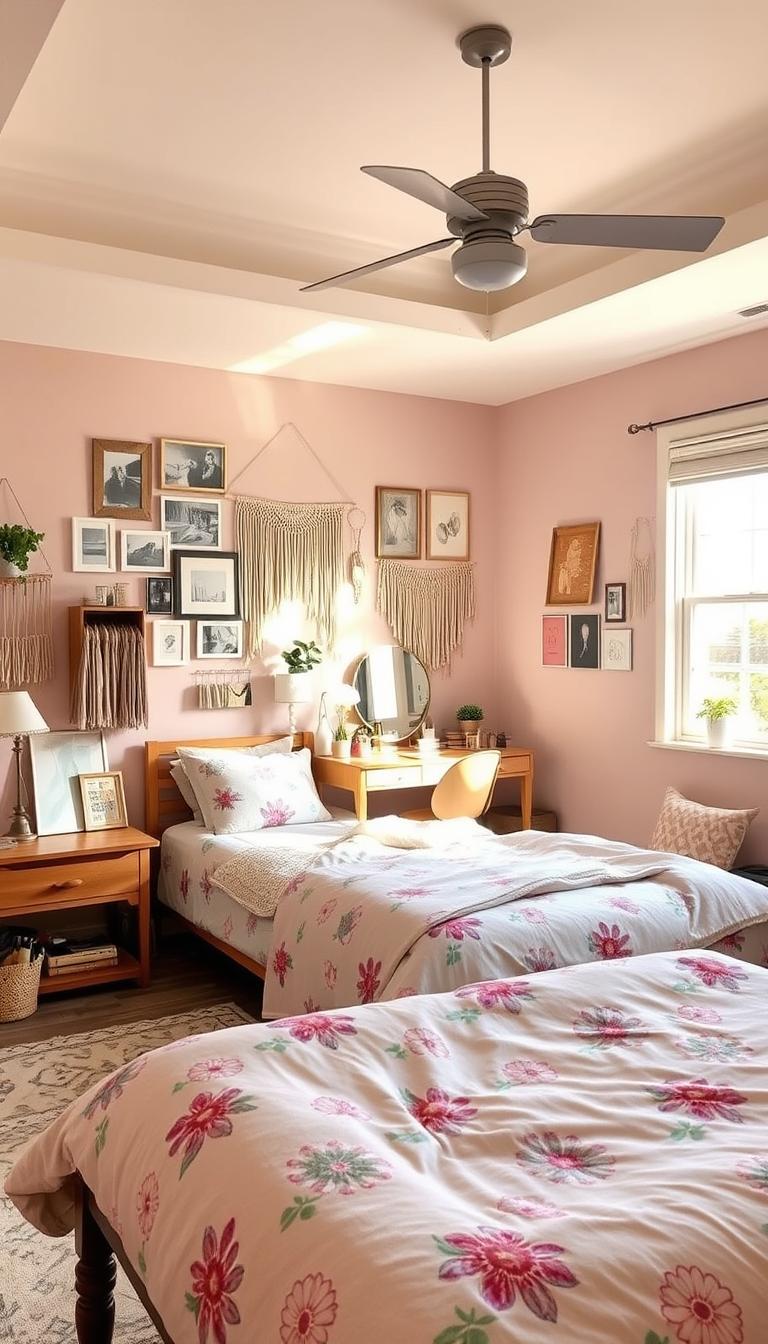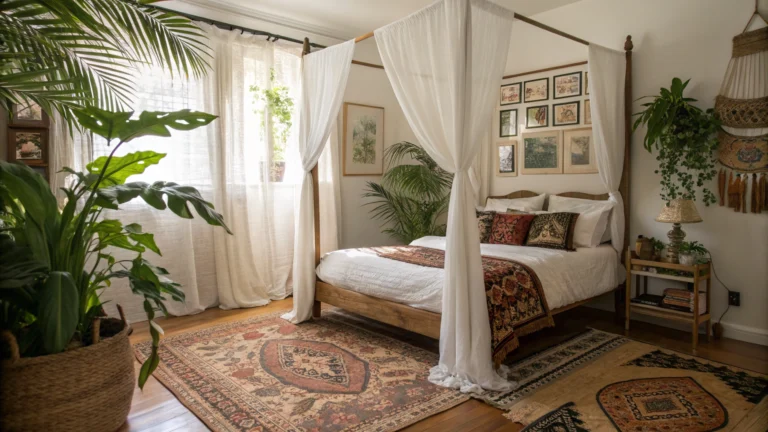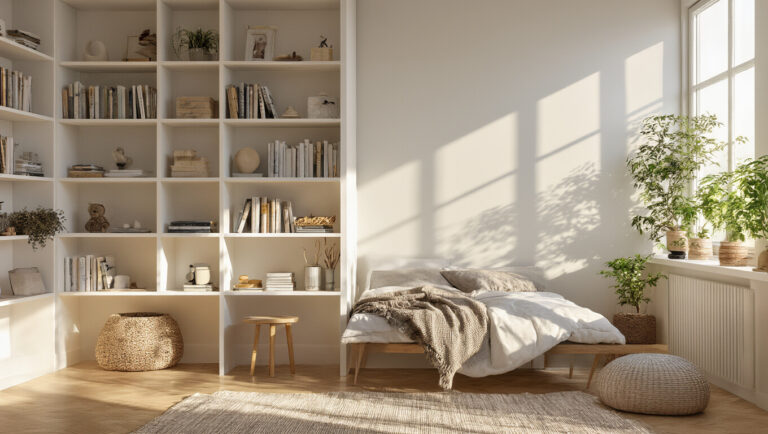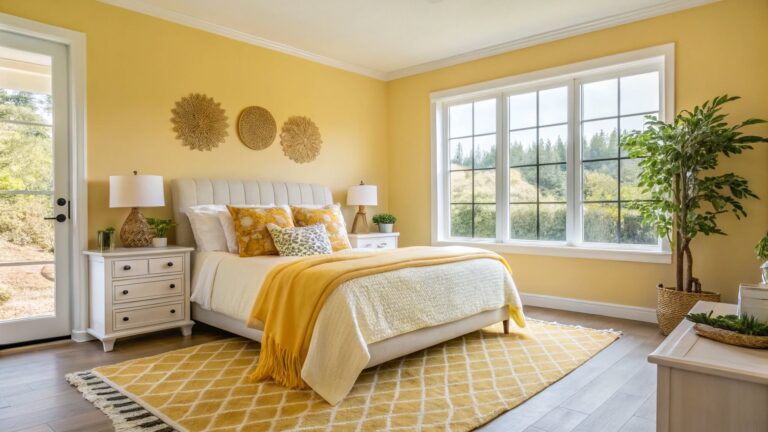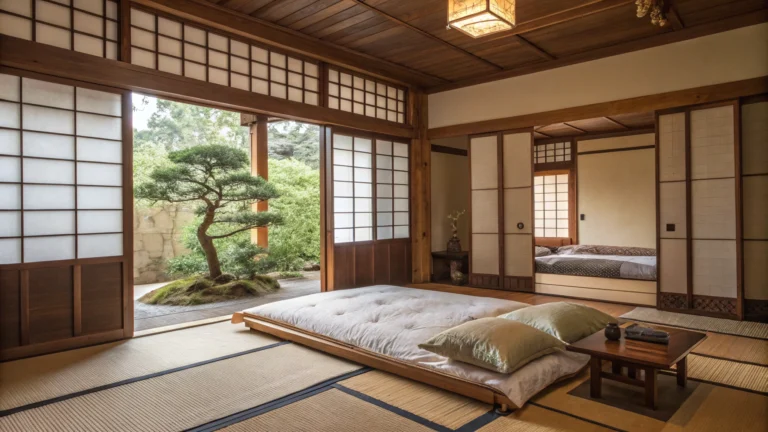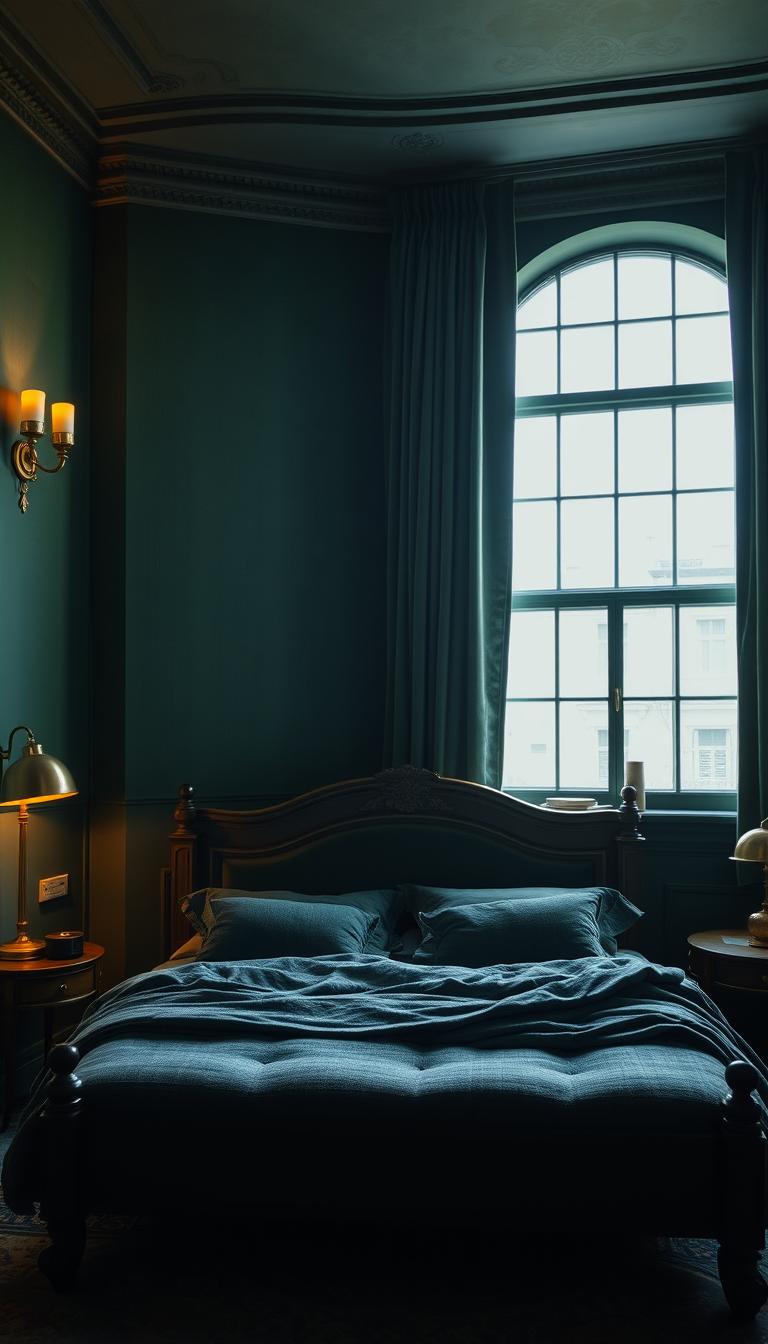Dark Earthy Bedroom Decor: Creating a Cozy Oasis
Imagine a sleep space that wraps you in warmth, blending rich tones and organic textures for ultimate relaxation. This design trend taps into nature’s palette, using deep hues and raw materials to craft a calming retreat. It’s more than aesthetics—it’s about building a sanctuary where comfort meets style.
Earthy interiors are gaining traction as homeowners seek refuge from fast-paced lifestyles. Think weathered wood accents, stone-inspired finishes, and hints of greenery. These elements work together to soften sharp edges and add depth, creating an environment that feels both grounded and inviting.
In this guide, we’ll explore how to balance moody shades with natural light, choose sustainable fabrics, and layer textures for visual interest. You’ll discover practical tips for mixing functional furniture with decorative pieces that reflect your personal taste. From linen bedding to handcrafted ceramics, every detail contributes to the overall harmony.
Ready to reimagine your private haven? Let’s dive into creative ways to blend functionality with organic charm, ensuring your space feels like a breath of fresh air—even in the heart of the city.
Introduction to Earthy Bedroom Trends
Modern sleep spaces are evolving into nature-inspired retreats, blending organic materials with soothing palettes. Designers increasingly focus on raw textures like linen bedding, clay pottery, and reclaimed wood to ground the room. These elements create balance—softening modern lines while adding warmth to the area.
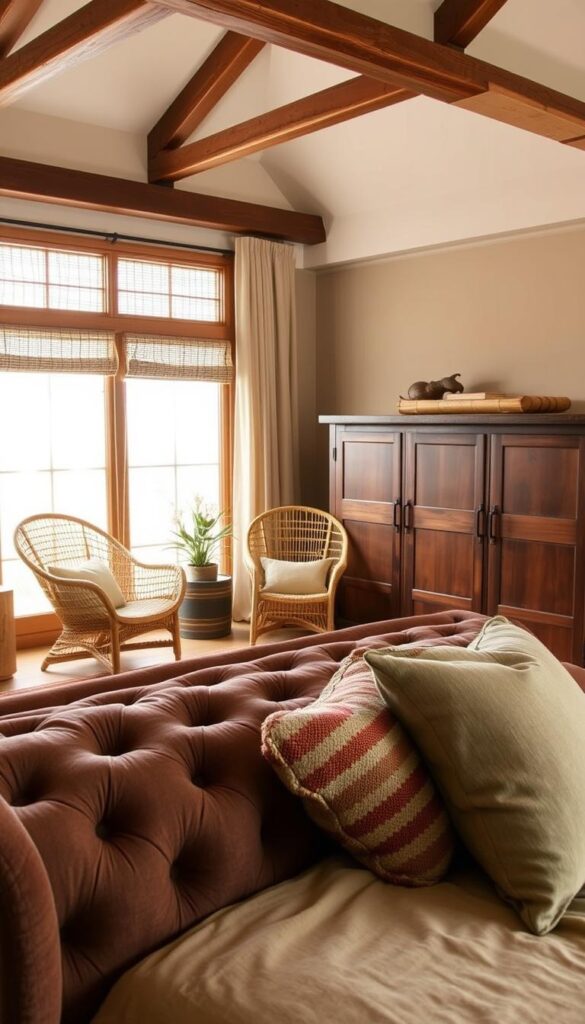
Wall colors set the tone for harmony. Warm grays, soft moss greens, and muted terracottas work well as base shades. Pair them with bold accents like brass lamps or indigo-dyed throws to add personality without overwhelming the space.
| Material | Visual Impact | Use Case |
|---|---|---|
| Reclaimed Wood | Adds rustic warmth | Headboard or floating shelves |
| Woven Jute | Introduces texture | Area rugs or storage baskets |
| Textured Stone | Creates organic contrast | Accent wall or bedside decor |
Current trends favor tactile experiences. Think nubby wool throws, hand-carved nightstands, or rattan light fixtures. These details connect the room to natural environments, promoting relaxation.
For cohesive styling, layer materials gradually. Start with foundational pieces like a neutral sofa bed, then add character through smaller decor items. This approach keeps the space functional yet visually engaging.
Benefits of a Cozy, Dark Earthy Bedroom
Science confirms what your instincts already know: rooms styled with natural elements and muted tones help you unwind. These spaces lower cortisol levels by up to 15%, according to recent studies, while fostering a stronger bond with the outdoors. It’s like bringing the serenity of a forest retreat into your home.
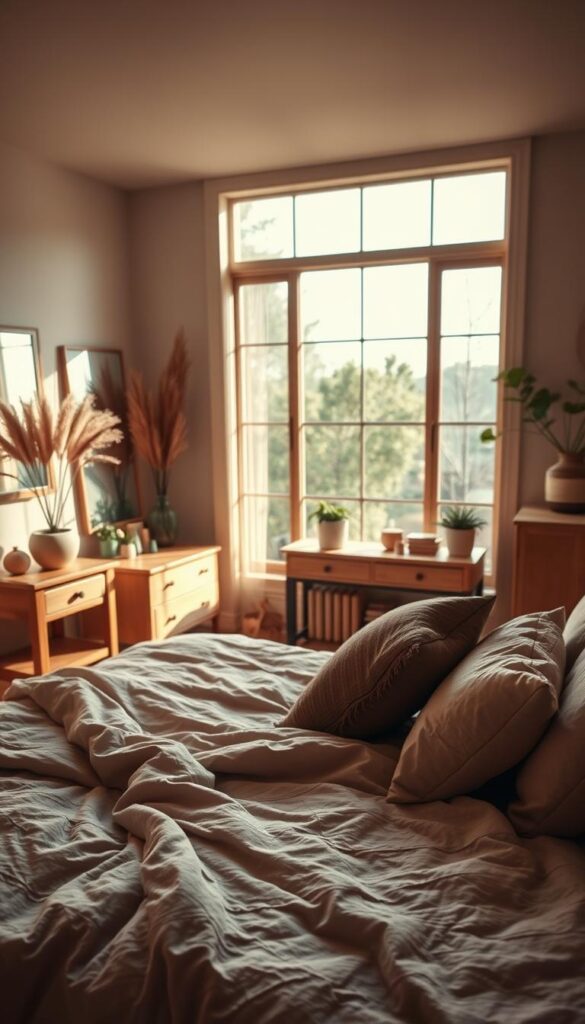
Soft, diffused lighting paired with deep terracotta or charcoal walls creates instant intimacy. This combination minimizes visual noise, letting your mind shift into relaxation mode. Add plush bedding made from organic cotton or linen—their breathable textures regulate body temperature for deeper sleep.
Natural decor plays a dual role. A jute rug underfoot or a stone vase on the nightstand adds tactile interest while grounding the area. These materials emit subtle earthy scents, further enhancing the calming atmosphere. Even small touches matter: a handwoven throw or clay lamp base can elevate your sense of comfort.
For a balanced look, layer functional and decorative items. Try these ideas:
- Swap synthetic curtains for linen drapes to filter natural light gently
- Use a reclaimed wood headboard to anchor the bed
- Place a Himalayan salt lamp nearby for warm, amber-toned glow
Quality bedding and intentional decor choices work together to build harmony. The result? A sanctuary that supports both restful nights and mindful mornings.
Embracing Earth Tones and Natural Colors
Color choices shape how we experience a room. Earthy tones like warm beiges and soft greens act as visual anchors, creating calm through their organic simplicity. These colors work together to form a cohesive backdrop that feels both intentional and effortless.
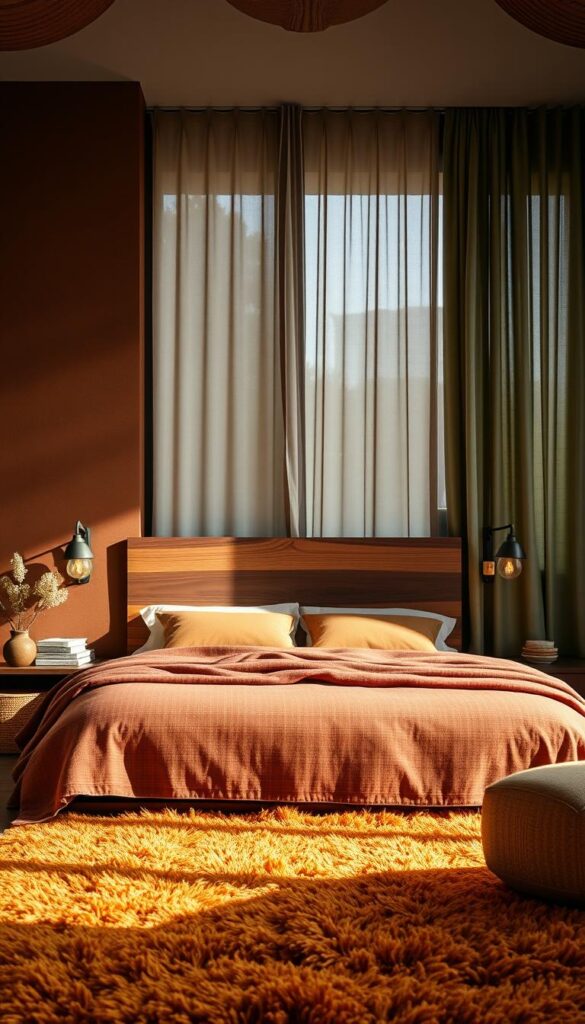
Soft natural shades transform stark spaces into restful zones. Muted sage walls paired with creamy linen curtains soften artificial lighting, while rich brown accents add warmth. This approach turns clinical areas into inviting retreats that encourage relaxation.
Three effective palettes stand out:
| Base Color | Accent Hue | Mood Created |
|---|---|---|
| Warm Beige | Charcoal Gray | Balanced Neutrality |
| Moss Green | Terracotta | Organic Warmth |
| Oatmeal | Deep Navy | Subtle Contrast |
Contrasting hues add depth without chaos. Try pairing clay-colored bedding with slate blue pillows. These combinations create movement while keeping the space grounded. Natural materials like rattan lamps or jute rugs enhance the color story through texture.
Warmer tones make large rooms feel cozier, while cooler shades help compact spaces breathe. Test samples at different times of day—colors shift with natural light. This attention to detail elevates both aesthetics and comfort, proving that thoughtful color selection impacts more than just looks.
Incorporating Natural Materials in Bedroom Furniture
Natural materials in furniture design go beyond trends—they create spaces that age gracefully while connecting us to the outdoors. Designers often prioritize reclaimed wood and stone for their ability to add raw, authentic character. These materials ground your space with organic textures that synthetic alternatives can’t replicate.
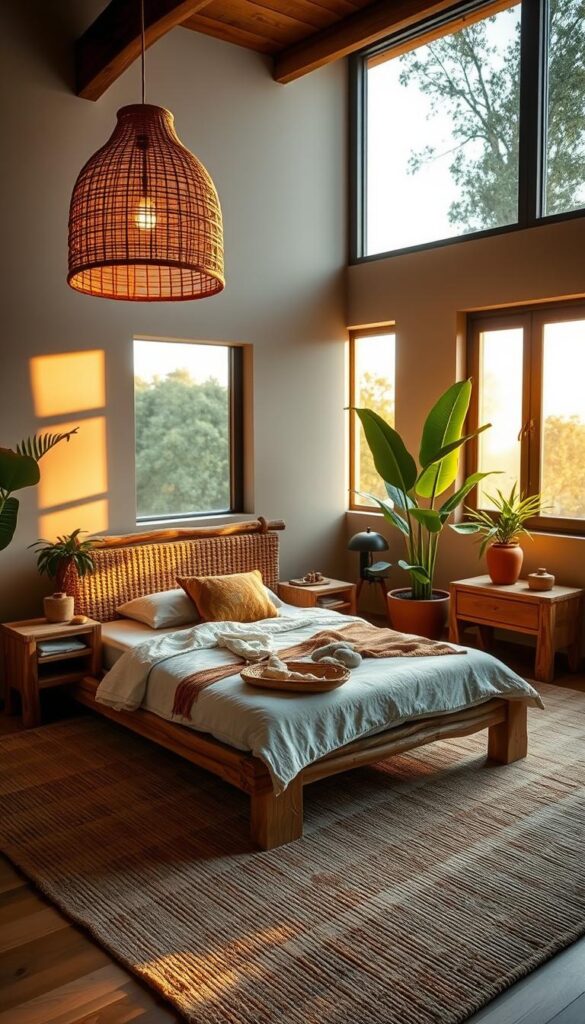
Reclaimed wood pieces tell a story through their knots and grain patterns. A rustic bed frame crafted from salvaged timber becomes the room’s focal point, while stone-topped nightstands offer cool contrast. These choices promote sustainability without sacrificing style.
Three key benefits of natural furniture materials:
- Tactile appeal: Rough-hewn wood surfaces and smooth stone finishes engage the senses
- Visual harmony: Neutral tones blend effortlessly with existing decor
- Longevity: Durable materials withstand daily use while developing patina over time
Quality craftsmanship elevates these pieces from functional to artistic. Handwoven rattan chairs or linen-upholstered benches add subtle texture. Natural fiber accents like jute rugs complete the look, tying the room together with earthy charm.
When selecting furniture, consider pieces that balance form and purpose. A live-edge desk or stone-based lamp base brings nature’s essence into your home. These investments offer lasting value, proving that thoughtful material choices create spaces you’ll love for years.
Inspiring Bedding and Textiles for a Cozy Retreat
Your bed becomes the heart of relaxation when dressed in thoughtfully chosen textiles. Start with organic cotton or linen sheets—their breathable nature keeps you cool in summer and warm in winter. These natural fibers age beautifully, softening with each wash while maintaining their durability.
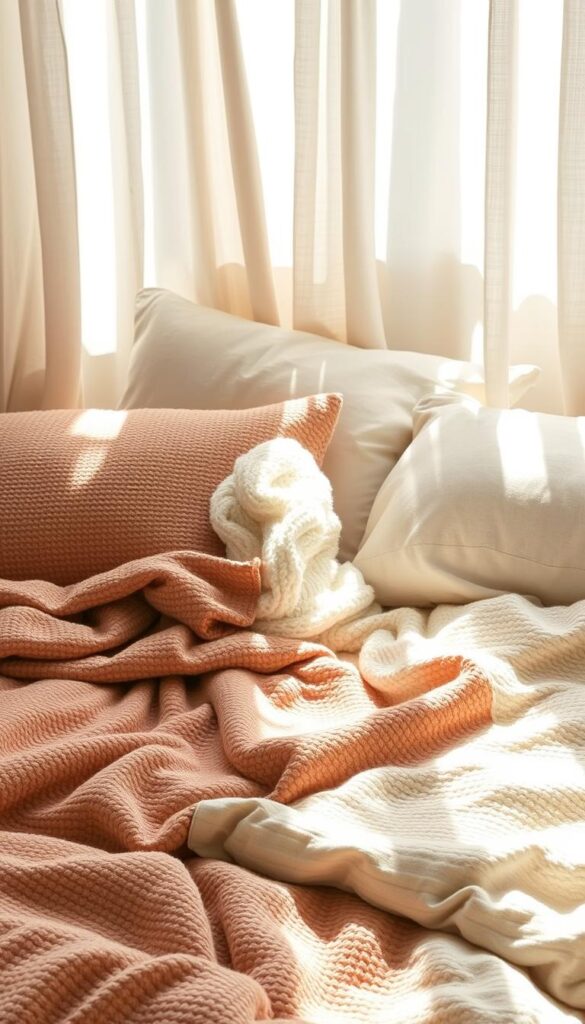
Layer earthy-toned duvet covers in muted clay or slate patterns for visual depth. Add a chunky knit throw or nubby wool blanket to introduce contrasting textures. This mix creates tactile interest without overwhelming the senses.
Decorative pillows offer both comfort and style. Try pairing linen shams with velvet lumbar pillows for a balanced look. Keep color schemes cohesive by sticking to three complementary hues from nature’s palette.
| Material | Benefits | Best Use |
|---|---|---|
| Organic Cotton | Breathable, hypoallergenic | Base sheets |
| Linen | Textured, moisture-wicking | Duvet covers |
| Bamboo | Silky, eco-friendly | Accent throws |
For a polished finish, fold a lightweight woven blanket at the foot of the bed. Rotate seasonal textiles—swap heavy quilts for gauzy cotton coverlets as temperatures rise. These small changes keep your retreat feeling fresh year-round.
The Art of Layering with Rugs and Textures
Layering rugs and textures isn’t just a trend—it’s a design strategy that adds depth and warmth. Start with a natural fiber base like jute or sisal. These durable materials ground the space while introducing subtle texture underfoot.
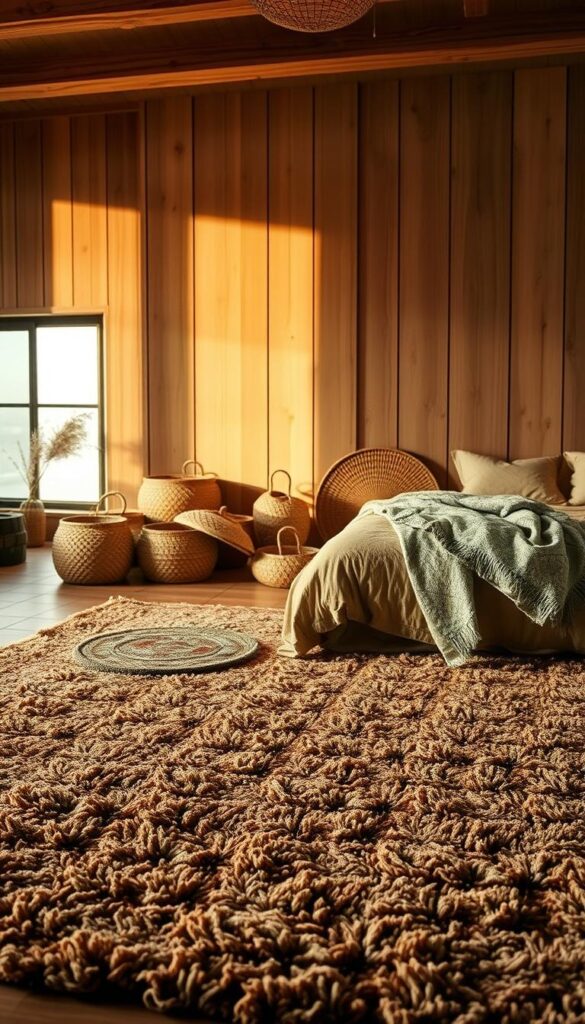
Pair a larger neutral rug with a smaller patterned one for contrast. Try placing a geometric wool piece over a sisal base. This mix creates visual interest without clashing. The key? Keep color palettes cohesive, using tones found in nature like warm browns or muted greens.
| Material | Texture | Best Use |
|---|---|---|
| Jute | Coarse, organic | Base layer |
| Sisal | Tightly woven | High-traffic areas |
| Wool | Soft, plush | Top layer |
Add dimension with woven throw blankets or nubby pillows. A chunky knit draped over a chair complements smooth linen curtains. These accents invite touch while reinforcing the organic theme.
Use area rugs to define zones in larger spaces. A circular rug under a reading nook ties together nearby decor. Layered textures transform functional pieces into artistic statements, proving that comfort and sophistication go hand in hand.
Styling Your Dark Earthy Bedroom to Perfection
Crafting a cohesive look requires equal parts strategy and creativity. Designers often start with a standout piece like a custom linen headboard, which anchors the space while adding tactile interest. Keep walls moody but balanced—pair deep charcoal with sand-colored drapes to prevent the room from feeling too heavy.
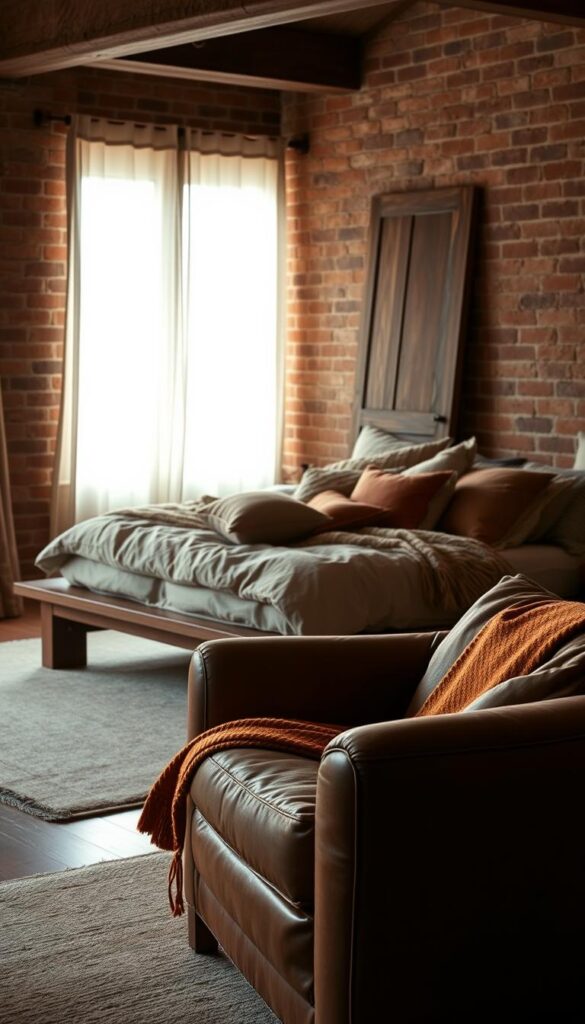
Statement furniture elevates the style instantly. Try a live-edge walnut nightstand or a rattan bench at the foot of the bed. These pieces add organic character without overwhelming the layout. Leave breathing room between items—clutter disrupts the calming vibe.
| Focus Area | Design Choice | Impact |
|---|---|---|
| Headboard | Custom upholstered in velvet | Adds luxe texture |
| Lighting | Layered brass sconces + pendant | Creates warm ambiance |
| Textiles | Linen + wool blend throws | Introduces cozy contrast |
Balance bold hues with lighter accents. Cream pillows on a chocolate-hued bed soften the look. Add personality through curated decor—stack art books on a side table or display hand-thrown pottery on floating shelves.
Arrange furniture to maximize flow. Position the bed opposite windows to highlight natural light. Use multifunctional pieces like storage ottomans to maintain clean lines. Finish with vintage finds—a weathered mirror or antique rug adds timeless charm to modern layouts.
Captivating Accent Walls and Wallpaper Trends
Transform your space with one bold design move: an accent wall. Designers love this technique for its power to draw attention while maintaining balance. Textured wallpaper or striking paint choices turn blank walls into artistic statements, adding depth without overcrowding the room.
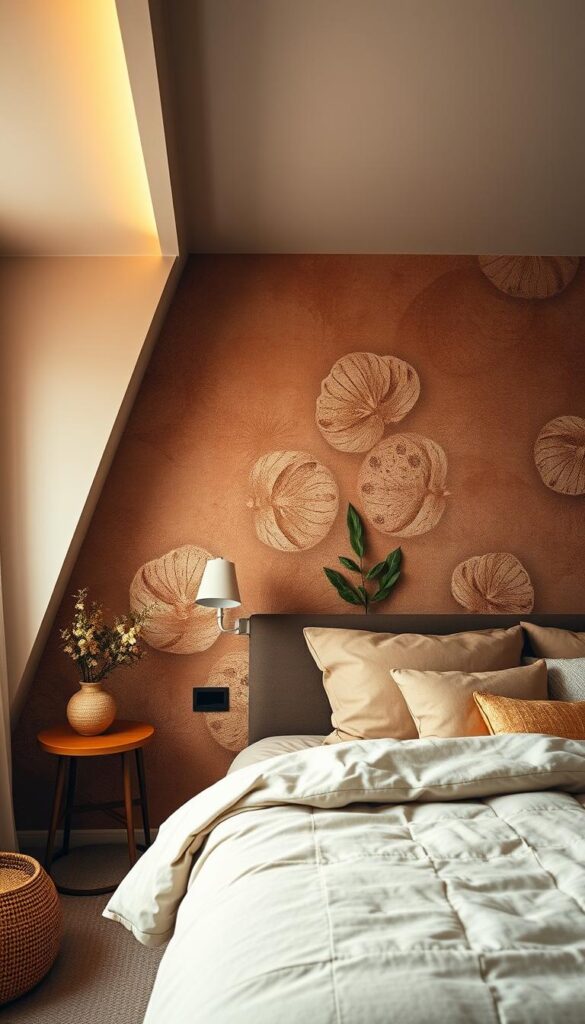
Nature-inspired patterns dominate current wallpaper trends. Think fern motifs, stone imitations, or woven grass cloth designs. These textures mimic outdoor elements, creating organic focal points. Botanical prints with oversized leaves or subtle floral repeats bring vitality to neutral spaces.
Contrasting paint shades work wonders for highlighting architectural features. Try deep olive behind a bed frame or warm taupe on a reading nook wall. These strategic color choices guide the eye and define zones in open layouts.
| Wallpaper Pattern | Best Use | Style Impact |
|---|---|---|
| Linen Weave | Behind headboards | Adds subtle texture |
| Geometric Earth Tones | Smaller walls | Creates modern contrast |
| Embossed Clay | Entry walls | Offers tactile appeal |
Pair your accent wall with complementary textiles. Linen curtains in matching tones soften bold patterns, while metallic curtain rods add refined contrast. Complete the look with woven baskets or ceramic vases that echo the wall’s texture.
These design choices craft spaces that feel both curated and welcoming. Whether using paint or paper, accent walls prove that strategic details make memorable impressions.
Ambient, Task, and Accent Lighting Strategies
Lighting layers transform spaces from functional to magical. Three types work together: ambient for overall glow, task for focused activities, and accent for artistic flair. Each plays a distinct role in crafting a balanced atmosphere that adapts to your needs.
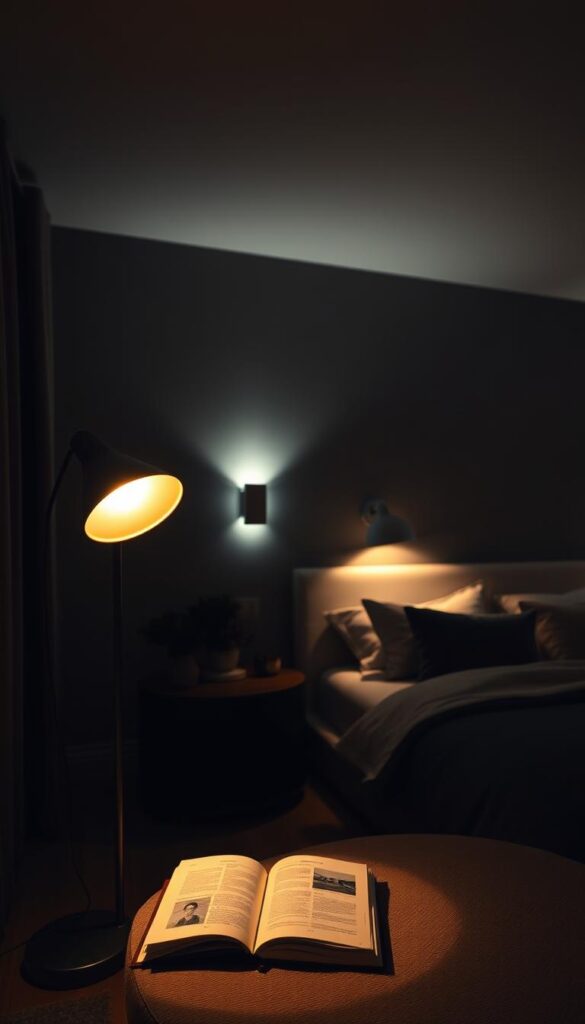
Start with ambient sources like pendant lights or wall-mounted fixtures. Warm 2700K bulbs mimic sunset hues, softening harsh edges. Natural fiber lampshades—rattan or linen—diffuse light gently while complementing organic decor themes.
Task lighting shines where you need it most. Adjustable swing-arm lamps suit late-night reading, while ceramic table lamps with woven bases add style to nightstands. Choose dimmable options to control brightness during winding-down routines.
| Light Type | Purpose | Example |
|---|---|---|
| Ambient | General illumination | Pendant lights |
| Task | Activity-focused | Adjustable desk lamps |
| Accent | Highlight features | Track lighting |
Accent lights draw attention to cherished details. Try slim LED strips behind headboards or directional spotlights above artwork. These subtle touches create depth without overwhelming the senses.
Balance is key. Layer floor lamps with tabletop fixtures to eliminate dark corners while maintaining cozy vibes. Mix materials like matte black metal and unglazed pottery for fixtures that feel both modern and rooted in nature.
Infusing Nature with Botanical Decor and Indoor Plants
Breathing life into your sanctuary starts with nature’s touch. Interior designers emphasize plants and botanical motifs to create spaces that feel alive and connected to the outdoors. These elements purify air while adding dynamic color shifts through their foliage.
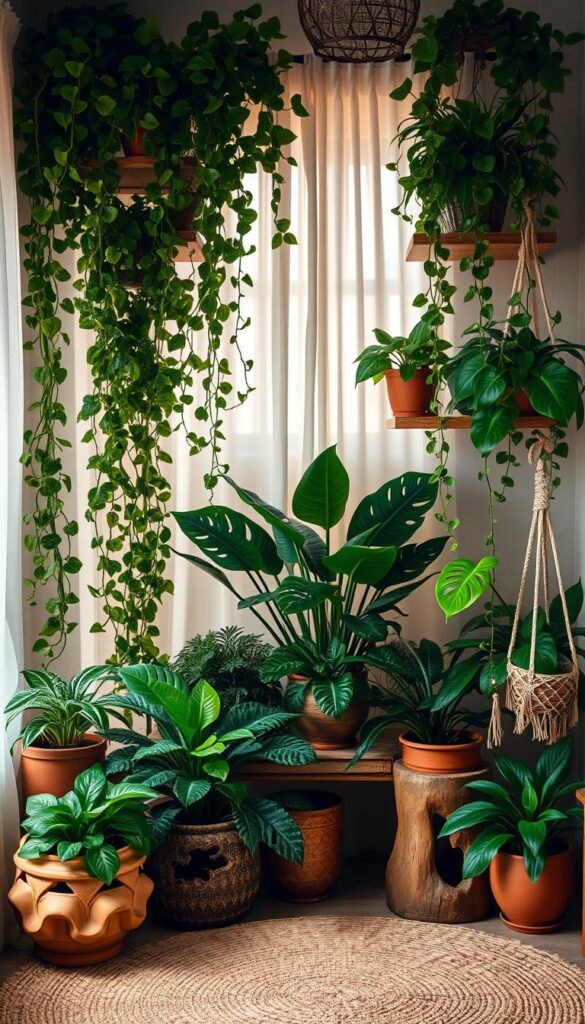
Low-maintenance greenery thrives in sleep-friendly environments. Snake plants filter toxins and release oxygen overnight, making them ideal companions. Succulents in terracotta pots introduce sculptural shapes, while trailing pothos vines soften shelves with organic movement.
| Plant | Benefits | Care Level |
|---|---|---|
| Snake Plant | Air purification | Minimal water |
| ZZ Plant | Thrives in low light | Monthly watering |
| Spider Plant | Removes pollutants | Weekly misting |
| Pothos | Trailing visual interest | Bright indirect light |
Botanical prints reinforce the theme without upkeep. Framed fern illustrations or oversized leaf patterns on cushions create cohesive storytelling. Pair these with raw wood frames or linen canvases for texture contrast.
Group plants in odd numbers for visual balance. A trio of succulents on a nightstand complements woven wall hangings. Larger specimens like fiddle-leaf figs anchor corners, blending modern minimalism with wild beauty.
This fusion of living decor and artistic accents cultivates rejuvenation. Plants become natural sculptures, while prints echo their organic forms. Together, they craft spaces where calm and vitality coexist effortlessly.
Eco-Friendly and Sustainable Design Choices
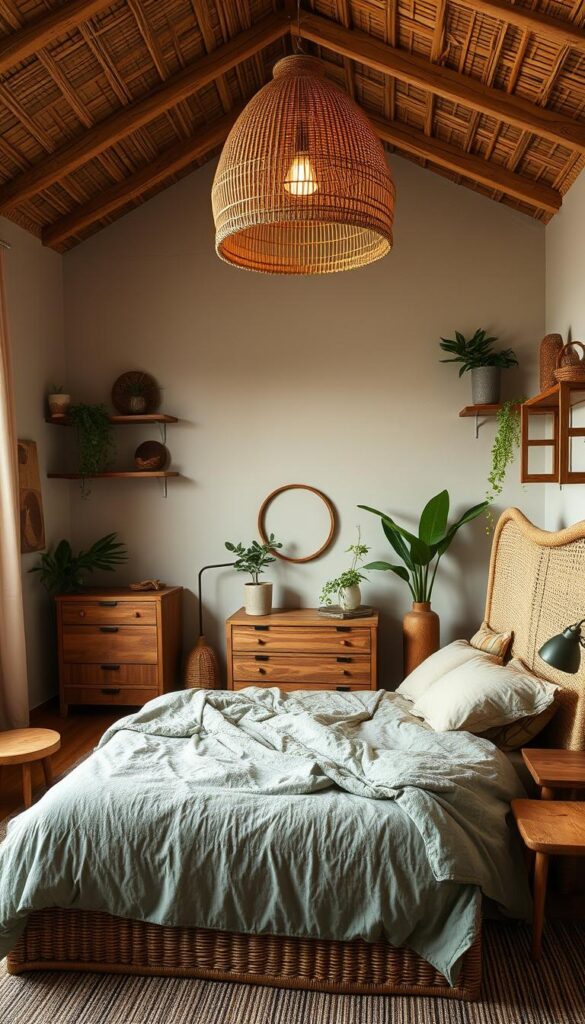
Sustainable living spaces prove that eco-friendly options can elevate your home’s comfort and look. By selecting materials mindfully, you create environments that nurture both people and the planet. Organic cotton bedding and reclaimed wood furniture offer style without environmental guilt.
Low-VOC paints improve air quality while providing rich, lasting color. These finishes reduce harmful emissions, making spaces healthier. Pair them with natural stone surfaces for tactile elegance that ages beautifully.
Three eco-chic elements to consider:
- Recycled metal light fixtures with industrial charm
- Bamboo blinds crafted from sustainable materials
- Handmade ceramic decor from local artisans
Quality sustainable pieces become timeless investments. They add character while supporting ethical practices. Every choice—from non-toxic rugs to energy-efficient lighting—shapes a greener future.
Prioritize durability over trends. Seek certifications like FSC wood or GOTS textiles for natural materials. Your home becomes a testament to thoughtful design that honors nature’s balance.
Earthy Color Palettes from Trend Inspirations
The right blend of hues can transform a room’s energy while reflecting nature’s calming essence. Current bedroom design trends lean into warm neutrals like terracotta and toasted almond, creating spaces that feel both modern and timeless. These palettes work like a visual hug—subtle yet deeply comforting.
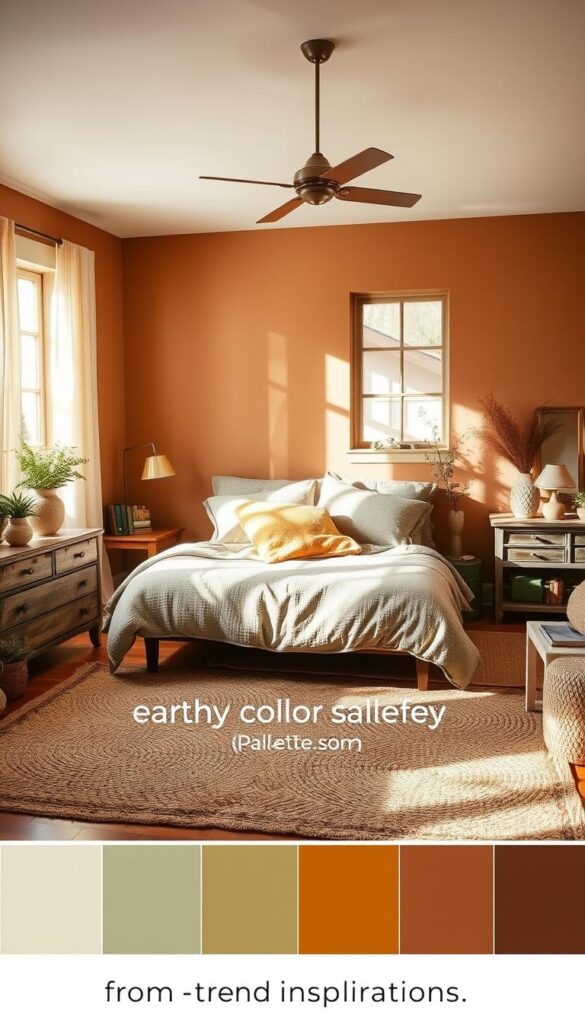
Designers recommend starting with a base of muted clay or warm taupe walls. Layer in deeper shades through textiles and art. For example, pair sand-colored linen curtains with chocolate-brown throw pillows. This approach maintains airiness while adding dimension.
| Base Color | Accent Hue | Effect |
|---|---|---|
| Warm Taupe | Sage Green | Serene Balance |
| Terracotta | Mustard Yellow | Energetic Warmth |
| Slate Gray | Burnt Orange | Modern Contrast |
Accessories offer safe ways to experiment. Try a rust-colored ceramic vase on a nightstand or ochre-toned artwork above the bed. These pops of color enliven neutral backdrops without overwhelming.
Test your palette in different lighting conditions. Morning sun softens cool grays, while evening lamps deepen caramel tones. Mix three main colors and two accents for cohesion—this formula works across various bedroom design styles.
Remember: successful schemes tell a story. Let your walls whisper while furnishings sing in harmony. This balance creates spaces that feel curated yet effortlessly welcoming.
Customizing with Personal and Vintage Touches
Your private retreat gains soul when infused with items that tell your story. Designers emphasize blending cherished heirlooms with modern elements to craft spaces that feel authentically yours. A vintage frame holding family photos or a retro lamp base adds layers of personality no store-bought decor can match.
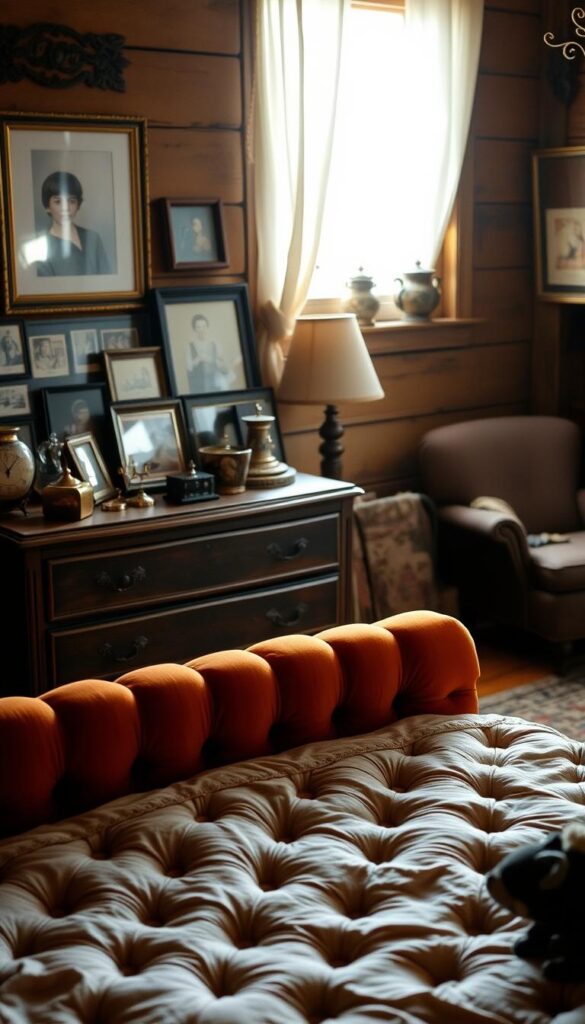
Unique pieces spark conversation and comfort. Try pairing a hand-me-down quilt with crisp linen sheets. This mix honors tradition while keeping the look fresh. Flea market finds like weathered mirrors or ceramic vases introduce texture without overwhelming the space.
| Vintage Item | Style Impact | Placement Tip |
|---|---|---|
| Antique Frame | Adds historical texture | Wall gallery above dresser |
| Retro Alarm Clock | Offers nostalgic charm | Nightstand accent |
| Handwoven Basket | Introduces organic warmth | Blanket storage |
Creative bedroom ideas thrive on contrast. Display childhood keepsakes on floating shelves near modern art prints. Use grandma’s jewelry box as a trinket catcher. These touches create visual interest while celebrating personal history.
Customization makes spaces unforgettable. Rotate travel souvenirs or handmade crafts seasonally. Blend textures through embroidered pillows or carved wood trays. Your sanctuary becomes a living scrapbook that evolves with you.
Creating a Multi-Sensory Bedroom Experience
Have you ever walked into a room that immediately calms your mind? The secret lies in designing spaces that engage every sense. Experts recommend blending sound, scent, and tactile elements to craft environments where relaxation feels effortless.
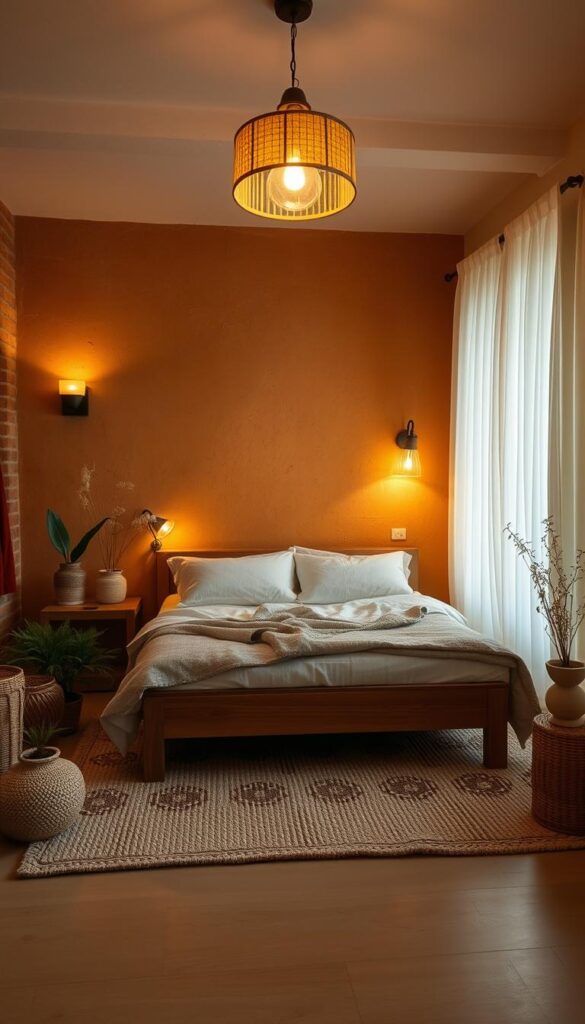
Soundscapes shape the room’s energy. Try a tabletop fountain with trickling water or discreet speakers playing forest bird songs. These subtle noises mask urban distractions while creating natural rhythms that ease tension.
Textures invite physical connection. Layer a nubby wool rug over smooth hardwood floors. Add velvet throw pillows to a linen-upholstered chair. Mix matte ceramic lamps with polished stone coasters for contrast.
| Sense | Elements | Benefit |
|---|---|---|
| Touch | Braided jute baskets, ribbed knit blankets | Encourages grounding |
| Smell | Lavender diffusers, cedarwood candles | Reduces stress hormones |
| Sight | Dimmable amber lighting, curved decor shapes | Softens visual edges |
Aromatherapy enhances the atmosphere. Use essential oils like bergamot or chamomile in reed diffusers. Avoid overpowering scents—opt for gentle fragrances that linger like fresh linen or rain-soaked soil.
Visual harmony ties everything together. Install warm-glow sconces near artwork to create focal points. Arrange varying-height decor to guide the eye naturally. These creative ideas help all elements work in unison, building a holistic sense of calm.
Tips and Tricks for a Serene, Inviting Space
What transforms a basic room into a calming retreat? Start by positioning your bed as the focal point. Center it on the main wall, leaving equal walking space on both sides. This creates balance while making the area feel intentional.
- Use woven baskets under nightstands for quick storage
- Install floating shelves to display 3-5 meaningful decor items
- Rotate seasonal accessories instead of crowding surfaces
Strategic lighting enhances key features. Highlight an accent wall with directional sconces or place table lamps near textured throw pillows. This draws attention to design details without visual chaos.
| Layout Strategy | Space Benefit | Style Impact |
|---|---|---|
| Angled Bench | Creates walking path | Adds organic shape |
| Mirrored Nightstand | Reflects natural light | Modernizes traditional decor |
| Layered Rugs | Defines zones | Introduces texture contrast |
Mix materials thoughtfully. Pair smooth ceramic lamps with nubby linen bedding. Add a velvet pillow to a leather chair. These combinations engage touch while keeping the room cohesive.
Leave breathing room between furniture pieces. A 24-inch clearance around the bed improves flow. Test arrangements by walking through the space – if it feels cramped, remove one non-essential item.
Personalize with unexpected accents. Drape a vintage quilt across a modern bed frame or prop handmade pottery on shelves. Your space should whisper your story, not shout trends.
Conclusion
Embracing natural design elements brings both tranquility and character to your home. A thoughtfully styled bedroom becomes more than a sleep space—it’s a retreat that lowers stress and reconnects you with nature’s rhythms. By blending organic textures, warm lighting, and sustainable materials, you craft an environment that supports relaxation and self-expression.
Key strategies from layered rugs to botanical accents work together to build harmony. Prioritize materials like reclaimed wood or linen that age beautifully while reducing environmental impact. Remember to leave room for personal touches, whether through vintage finds or handmade decor that tells your story.
Your space should evolve with you. Experiment with clay-toned ceramics, woven wall hangings, or potted greenery to find what sparks joy. There’s no single “right” way—trust your instincts as you mix functional pieces with artistic details.
Ready to begin? Start small with a jute rug or organic bedding, then build outward. Every choice moves you closer to a sanctuary that reflects your unique connection to the natural world. Sweet dreams await!
